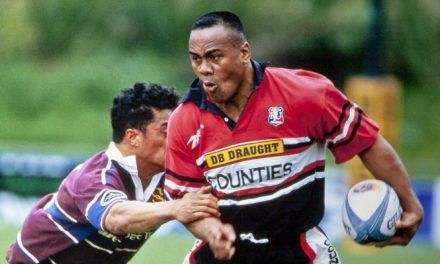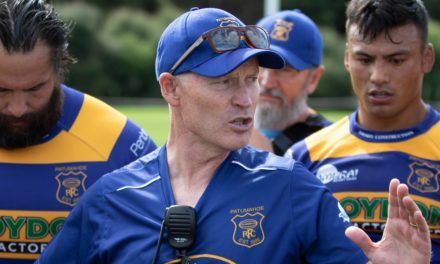


By Dale Budge
What would rugby look like if it prioritised a fan-first mentality and did away with anything that that didn’t sell the sport as entertainment?
All sports are faced with this dilemma at times – the balance between preserving the fundamental elements of their history with the need to attract new fans and engage with the masses – if you’re not growing, you’re dying.
But rugby might well be the one sport that has either found this the hardest thing to do or worst still, the one that hasn’t actually made any real effort to make a shift.
I think there is a misconception that rugby is at the crossroads right now in New Zealand – the reality is it had been several years ago, but they carried on down the wrong path and now urgent and extreme action is required to drag the sport to where it needs to be.
There is an entire generation out there that isn’t remotely interested in professional rugby – NPC, FPC, Super Rugby, Aupiki – whatever competition you list, people under the age of 30 are not paying attention to it.
So what are some immediate changes that could make the game more of a spectacle again?
Scrums
For an age, rugby fans have thumbed their nose at rugby league scrums and for good reason. League scrums can barely be described as a competition for the ball – they pack in loosely; binding is irrelevant, and they almost never push. But compare that to a rugby scrum and the impact on entertainment and you start to realise that league might be onto something. The 13-man code uses a scrum as a way to group all forwards together to allow a back-line to have more space. The ball is in and out quickly and play continues. League has even introduced more rules to remove scrums from the game in various circumstances to keep the ball in play.
Every time we see rugby set for a scrum, there is a nearly one-minute stoppage while players get ready, bind up and pack down for the scrum. Often we see them re-set or an infringement conceded that sees a team opt to take another scrum, wasting precious playing time.
Yes, rugby scrums are a genuine competition, but it comes at too big a price these days.
Breakdown rules
They are so complicated that even life-long rugby fans struggle to keep up with the constant tweaks and interpretations. There is also the very subjective element to what a referee sees and is comfy with that varies greatly from game to game. This area needs major simplification. In other codes – league, American Football, even soccer – there are contentious referee decisions that can be argued either way, but the basic rules are simple for new fans to understand. That cannot be said for rugby.
What if we simplify so that if a player is on his feet and entered from his team’s side of the ball, they have rights to use their hands? It would remove the current definitions of tackle, ruck and maul – and simply means the ball is contestable at all times so long as a player is standing and onside.
It would change the way the game is played significantly but teams will adapt and a more fan friendly contest would ensue.
Substitutions
What we see nowadays is teams replace almost their entire forward pack during the second half of matches. That means fatigue is not so much of a factor in the game.
Tries are fun, fans want to see scoring. Perhaps the best way to get more scoring is to create more fatigue and strip back the replacement rules.
Make it more like football in that a coach can only make a set number (three, maybe four) of substitutions throughout the game.
Rugby has prided itself on being a sport for all sizes but that doesn’t necessarily make people want to pay for tickets or television subscriptions. The NBA seems to be doing ok and it is hardly a sport for all sizes.
Red cards/Yellow cards
This is a difficult one – rugby is dealing with the threat of lawsuits from former players that are battling concussion. They are dealing with Mum’s and Dad’s concerned about their kids’ safety playing the game.
The cracking down on foul or dangerous play with cards is needed but it is also having too great an impact on the spectacle.
Maybe rugby could take a leaf out of ice hockey’s book and make it that when a player is yellow carded, if the opposing team scores a try that player is then eligible to return to play regardless of how much time is left to serve. It means that at most a team can concede one try while they are down a player.
Similarly with a red card, perhaps they make that player exit for the duration of the game but after 10 minutes, the team can use one of its substitutions to bring on a replacement.
Where the professional game is played
There is constant debate in New Zealand about how many levels of rugby we have and how many professional teams are viable financially. It seems five Super franchises and 14 provinces is too many teams and nearly double that if you separate that out to the men’s and women’s games.
If we got rid of NPC as it appears NZ Rugby is keen to do, that leaves only five franchises and five regions represented.
It needs to be more than that.
Go the other way and get rid of the Super franchises as we know them and revert back to provinces. Take the 10 leading provinces and make that the NPC 1 or Super Rugby equivalent. Give them all an even salary cap and share of the broadcast pie and play that competition with All Blacks taking part.
The remaining provinces could fall into a traditional NPC 2 and NPC 3 structure with one team earning automatic promotion and relegation from each division every season.
Make the NPC start in late February and run through to mid-May.
Club rugby could start properly after that while that is when international rugby would also take place.
It means elite All Blacks are playing in provincial colours in front of local fans while later in the year, the top non-All Blacks are playing club rugby.












Recent Comments